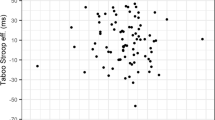Summary
A new functional response competition model to describe the cognitive processes underlying the Stroop phenomenon is proposed. The main challenge for any explanation is the asymmetry of the conflict, i.e. the fact that the meaning of the color word disturbs naming the color of an incongruent color-word-color stimulus far more than the irrelevant color disturbs reading the word. The model proposes that the organism processes both competing verbal responses by priming the relevant set and inhibiting the irrelevant set if both responses belong to different sets, and by computing internal delay-time differences if both responses belong to the same set. The model explains most of the existing data about the Stroop phenomenon and is in full accordance with present knowledge on selective attention, stimulus encoding, response selection, and psychological refractory period. It is confirmed by data of a Stroop experiment using a set of verbal color responses disjoint from the set of the stimulus color words. This experiment is based on the strategy often used in Stroop research to try to obtain a reversed Stroop effect in order to find an explanation of the Stroop effect. The data show full symmetry of competition, that is a Stroop effect and a reversed Stroop effect of about the same amount of increased reaction time.
Similar content being viewed by others
References
Bakan, P., Alperson, B.: Pronounceability, attensity, and interference in the color-word test. Amer. J. Psychol. 80, 416–420 (1967)
Bredenkamp, J.: Der Signifikanztest in der psychologischen Forschung. Frankfurt/M: Akademische Verlagsgesellschaft 1972
Comalli, P.E., Wapner, S., Werner, H.: Interference effects of Stroop color-word test in childhood, adulthood, and aging. J. Genet. Psychol. 100, 47–53 (1962)
Dalrymple-Alford, E.C.: Interlingual interference in a color-naming task. Psychon. Sci. 10, 215–216 (1968)
Dalrymple-Alford, E.C.: Associative facilitation and interference in the Stroop color-word task. Percept. Psychoph. 11, 274–276 (1972)
Dyer, F.N.: The duration of word meaning responses: Stroop interference for different preexposures of the word. Psychon. Sci. 25, 229–231 (1971)
Dyer, F.N.: The Stroop phenomenon and its use in the study of perceptual, cognitive, and response processes. Memory & Cognition 1, 106–120 (1973)
Dyer, F.N., Severance, L.J.: Stroop interference with successive presentations of separate incongruent words and colors. J. exp. Psychol. 98, 438–439 (1973)
Flowers, J.H.: “Sensory” interference in a word-color matching task. Percept. Psychoph. 18, 37–43 (1975)
Hamers, J.F., Lambert, W.E.: Bilingual interdependencies in auditory perception. J. verb. Learn. verb. Behav. 11, 303–310 (1972)
Jensen, A.R., Rohwer, W.D.: The Stroop color-word test: a review. Acta Psychologica 25, 36–93 (1966)
Kirk, R.E.: Experimental design: procedures for the behavioral sciences. Belmont, Calif.: Brooks/Cole Publ. Comp. 1968
Klein, G.S.: Semantic power measured through the interference of words with color-naming. Amer. J. Psychol. 77, 576–588 (1964)
Lund, F.H.: The rôle of practice in speed of association. J. exp. Psychol. 10, 424–433 (1927)
Morrison, D.E., Henkel, R.E.: The significance test controversy. Chicago/Ill.: Aldine Publ. Comp. 1970
Morton, J.: Categories of interference: verbal mediation and conflict in card sorting. Br. J. Psychol. 60, 329–346 (1969)
Morton, J.: A functional model for memory. In: Norman, D.A. (Ed.): Models of human memory. New York: Academic Press 1970
Morton, J., Chambers, S.M.: Selective attention to words and colours. Quart. J. exp. Psychol. 25, 387–397 (1973)
Nealis, P.M.: The Stroop phenomenon: some critical tests of the response competition hypothesis. Percept. Mot. Skills 37, 147–153 (1973)
Oppelt, W.: Kleines Handbuch technischer Regelvorgänge. Weinheim/Bergstr.: Verlag Chemie 1960
Pritchatt, D.: An investigation into some of the underlying associative verbal processes of the Stroop colour effect. Quart. J. Exp. Psychol. 20, 351–359 (1968)
Schiller, P.H.: Developmental study of color-word interference. J. exp. Psychol. 72, 105–108 (1966)
Schönpflug, W., Vetter, G.H.: Psychologische Kennwerte von Trigrammen. Meisenheim am Glan: Anton Hain 1975
Seymour, P.H.K.: A model for reading, naming and comparison. Br. J. Psychol. 64, 35–49 (1973)
Shor, R.E.: Symbol processing speed differences and symbol interference effects in a variety of concept domains. J. General Psychol. 85, 187–205 (1971)
Sichel, J.L., Chandler, K.A.: The color-word interference test: the effects of varied color-word combinations upon verbal response latency. J. Psychol. 72, 219–231 (1969)
Smith, M.C.: Theories of the psychological refractory period. Psychol. Bull. 67, 202–213 (1967)
Sternberg, S.: The discovery of processing stages: extensions of Donders' method. Acta Psychologica 30 Attention and Performance II (W.G. Koster, ed.) 276–315 (1969)
Stroop, J.R.: Studies of interference in serial verbal reactions. J. exp. Psychol. 18, 643–662 (1935)
Treisman, A.M.: Strategies and models of selective attention. Psychol. Rev. 76, 282–299 (1969)
Treisman, A.M., Fearnley, S.: The Stroop test: selective attention to colours and words. Nature 222, 437–439 (1969)
Uleman, J.S., Reeves, J.: A reversal of the Stroop interference effect, through scanning. Percept. Psychoph. 9, 293–295 (1971)
Windes, J.D.: Reaction time for numerical coding and naming of numerals. J. exp. Psychol. 78, 318–322 (1968)
Author information
Authors and Affiliations
Additional information
This paper is based on an experimental study conducted by Dipl.-Psych. Margrit O. Dolt under the supervision of Dr. W.R. Glaser and submitted as Diplomarbeit.
Rights and permissions
About this article
Cite this article
Glaser, W.R., Dolt, M.O. A functional model to localize the conflict underlying the stroop phenomenon. Psychol. Res 39, 287–310 (1977). https://doi.org/10.1007/BF00308930
Received:
Issue Date:
DOI: https://doi.org/10.1007/BF00308930




